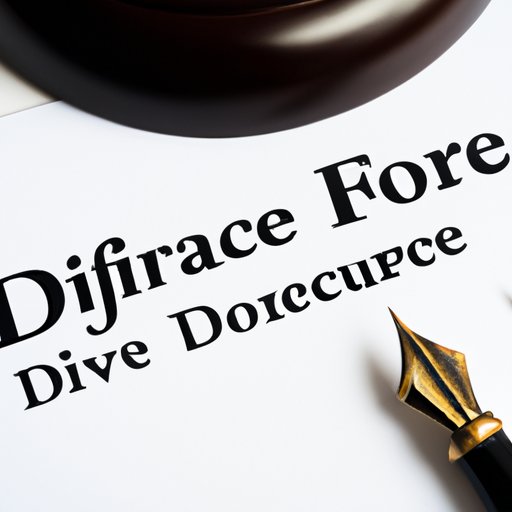
I. Introduction
Divorces can be expensive, and the cost is a major barrier for many couples seeking to end their marriage. However, there are several options available for those who cannot afford the high cost of divorce lawyers and filing fees. This article will explore the ways in which you can get a free divorce.
II. DIY Divorce: How to Navigate the Process on Your Own
A Do-It-Yourself divorce is an option for people who want to save money on legal fees. This method is only recommended for couples who have agreed on all aspects of the divorce, including property division, child custody, and spousal support.
To get started, you must first obtain the necessary divorce forms from your local county court. The forms can also be downloaded online from your state government website. Generally, the forms you need include a petition for divorce, a marital settlement agreement, and a final judgment of divorce.
Make sure to read and follow the instructions carefully. Mistakes can cost you time, money, and a headache. After completing the forms, file them with the county court clerk’s office and pay the filing fee. The court will review your paperwork and notify you of any corrections needed.
III. Fast-Tracking Your Divorce: Tips for Using Free Legal Aid Services
Free legal aid services are available to low-income individuals and families who cannot afford to pay for legal representation. These services are provided by non-profit organizations, legal clinics, and other community agencies.
To qualify for free legal aid, you will need to meet certain income requirements. You can find free legal aid services by visiting your state’s legal aid website, contacting your local bar association, or calling a law school clinic. After qualifying, a lawyer will be assigned to your case and will provide legal services, including representation in court, if necessary.
IV. Pro Bono Assistance: How to Find a Divorce Lawyer Who Will Work for Free
Pro bono assistance involves lawyers providing their services for free or a reduced cost. This service is provided for individuals who cannot afford to hire a lawyer. To qualify for pro bono assistance, you will need to meet the income requirements and other criteria set by the law firm or organization providing the service.
You can find pro bono lawyers by contacting your local bar association, law schools, or legal clinics. Make sure to provide a detailed explanation of your case and situation to help the lawyer understand your needs and how they can help you.
V. Navigating the Legal System: A Guide to Filing for a Fee Waiver
A fee waiver is a request to the court to waive the filing fees associated with your divorce. This request is granted based on income and financial hardship considerations. If your request for a fee waiver is approved, you could save up to $500 or more on your divorce.
To apply for a fee waiver, you will need to complete and submit a fee waiver form with your divorce petition. You will also need to provide proof of income, such as pay stubs or tax returns. It’s essential to check the eligibility requirements for a fee waiver in your state as it varies from state to state.
VI. Divorce Mediation: How to Settle Your Case for Free with Help from an Unbiased Third-Party
Divorce mediation is a process that involves a neutral third-party mediator who facilitates communication and negotiation between the spouses to reach a mutually acceptable agreement. The mediator does not take sides and is trained to help both parties set aside their emotions and focus on reaching a resolution that is best for both parties.
To find free mediation services, you can contact your county’s family court, legal aid office, or local mediators. In some states, the court may order or suggest mediation as part of the divorce process. Mediation is generally less expensive than traditional divorce and encourages a more collaborative and peaceful solution.
VII. Conclusion
Getting a free divorce can seem like a daunting task, but it is achievable with the right preparation and resources. In this article, we covered multiple options for people to get a free divorce, including DIY divorce, legal aid services, pro bono assistance, filing for a fee waiver, and using divorce mediation services. Remember, each method has its advantages and disadvantages, so it’s essential to choose the one that suits your needs and budget.
We hope that this article has provided you with helpful information and encouraged you that getting a divorce doesn’t have to break the bank. In addition to the resources mentioned in this article, you could also check with community organizations and churches for support groups that can provide practical and emotional support.





